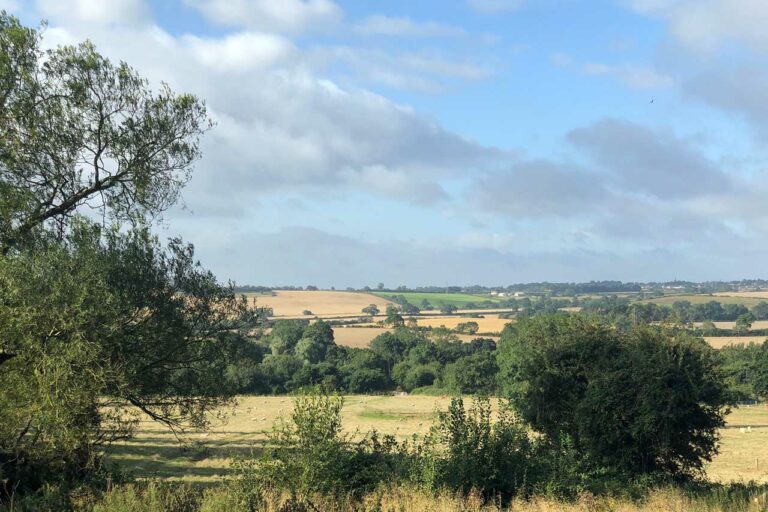Visiting the Tower of London
My #1 bucket list item when I visited England was The Tower of London. I love medieval fiction, especially books by the late great Sharon Kay Penman, and the Tower features so much in that time period that I just had to see it myself.
There are many reasons to visit The Tower of London. It is a UNESCO World Heritage Site, and a Listed Building that indicates its importance both architecturally and historically. It’s also a very popular destination for tourists, 2.8 million of whom come from near and far each year to visit the Tower. If you’d like to count yourself among that group of visitors, here are some things to know about the Tower of London before you visit.
History of the Tower of London
The Tower of London was originally built in 1068 by William the Conqueror, two years after he conquered England. The building that is now in the center of the property, called the White Tower, was the entire property at that time. The walls and other buildings came later.
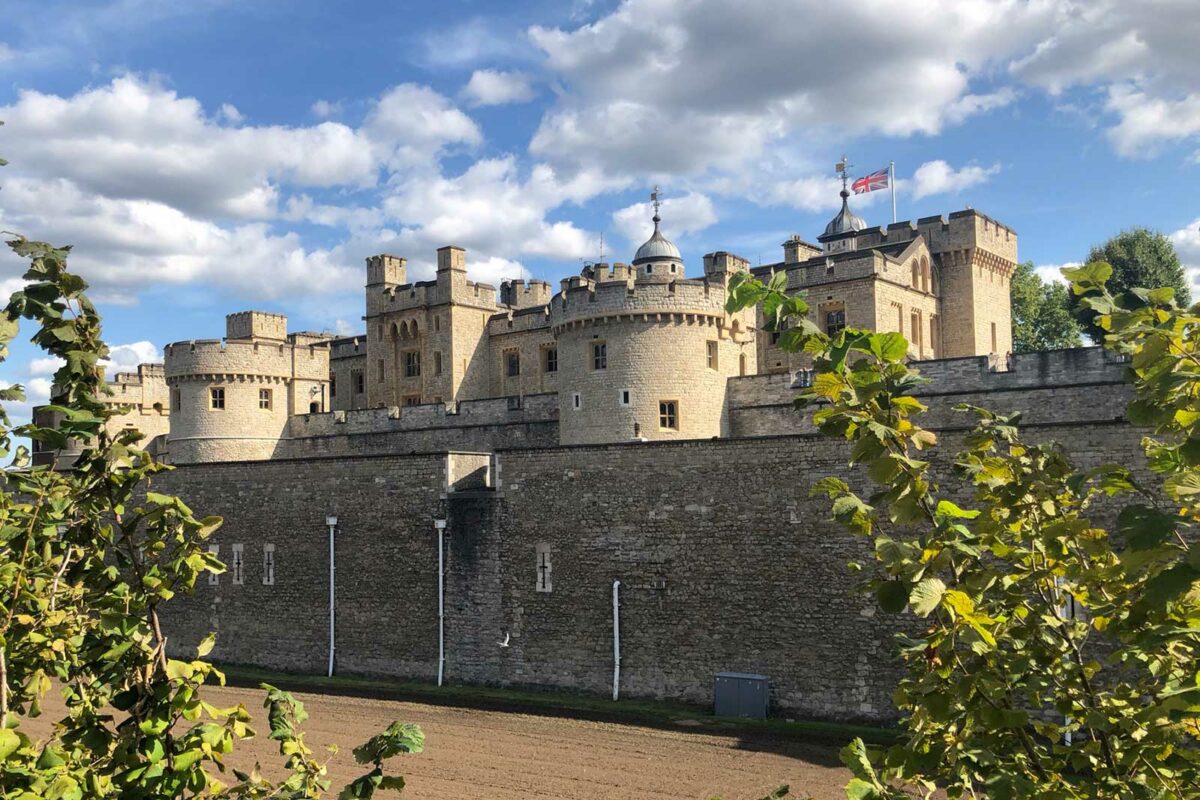
Many people think of the Tower of London as a prison, and of course it was so for much of its existence. But the White Tower was originally built as a palace, and a fine example of one, I might add. It was used as a royal residence by many of the Kings and Queens of England.
The entire complex was expanded over the centuries and now includes, in order from the center to the outskirts of the property:
- the White Tower at its center
- a grassy area called the “inner ward” that surrounds the White Tower on three sides
- the inner wall surrounding that
- the outer ward which lies between the two walls
- the outer wall
- the grassy moat
There are several other well-known parts of the Tower of London. The Church of St Peter ad Vincula is the final resting and burial place of several famous historical figures, many of who were also held prisoner at the tower. This esteemed though non-enviable list includes Queen Anne Boleyn, Queen Catherine Howard, Lady Jane Grey, Sir Thomas More, Thomas Cromwell, Sir Walter Raleigh, and many others.
Things to See at the Tower of London
Although it’s right in the middle of the city of London and doesn’t seem to occupy that much space, don’t be deceived. You really can’t see everything at the Tower of London in a single day. If you want to try, your best bet is to arrive before it opens, and head straight to the Waterloo Block, which houses the Crown Jewels.
The Crown Jewels of The United Kingdom
The Crown Jewels display is by far the most popular attraction at the Tower, and the one that you’ll wait in line the longest to see.
The Crown Jewels of The United Kingdom, as they are officially known today, are really something you’ll want to see. On display are a number of crowns, with lots of jewels embedded in them…the name pretty much speaks for itself. But there’s a lot more as well. There are processional objects like swords and maces, objects used during the anointing ceremony of several monarchs, robes, orbs, scepters and more. The Tower Guard keeps a watchful eye on these priceless objects, which are occasionally removed for use by Her Majesty for special occasions of national importance.
A flat people mover runs on both sides of the main display, in order to give visitors the best view and to prevent crowding.
Pay no attention to the conspiracy theory of those who say the jewels aren’t real. The Historic Royal Palaces says they are real, and so they are.
The Old Roman Wall
When you finish seeing the crown jewels, if you exit back toward the White Tower, you can see the remnants of the old Roman wall that ran across the land before the Tower was ever built. This wall was built around 200 A.D. when the Romans occupied what is now England, including the city of London, which they called Londinium. Wikipedia says “This wall largely defined the boundaries of the City of London until the later Middle Ages.”
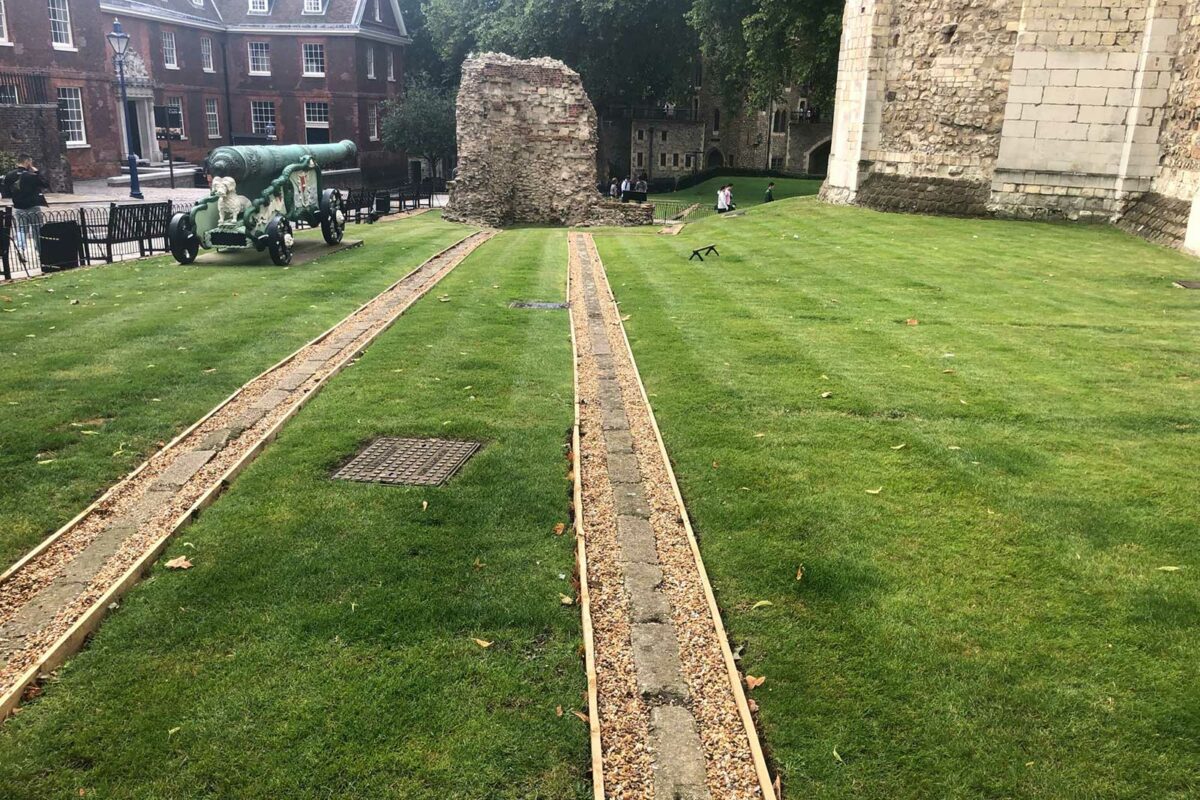
The actual Roman wall was mostly destroyed before the castle was built. However, the location is marked by two rows of stones on the east side of the White Tower. The Roman wall remains are shown above; they are the two stone “paths” along the ground. At the southern end of these two rows is a partial wall, but according to Archeology Travel, it dates back to the 11th or 12th century. (The article where this was published no longer appears to be online.) It is not actually part of the Roman wall; it’s part of a tower that was built later as part of the Tower of London complex.
However, you can see part of the actual Roman wall outside of the Tower of London property. If you exit the tube at the Tower Hill station to walk to the Tower itself, you’ll pass right by one of the largest sections of the wall that’s still standing. It’s kind of nice that this is available to any passerby to see, without having to purchase tickets!
The Tower Ravens
If you’ve spent much time on my blog, you may have already picked up on my love for travel that involves wildlife, especially birds, so getting to see the Tower Ravens was quite a treat for me.
There are supposed to always be a minimum of six ravens in residence at the Tower of London. The reason for this is a myth that says that Charles II was warned that if they ever left, the city of London would fall. Since that time, supposedly, there have always been at least six ravens at the Tower. There are large cages where the ravens can sleep at night, and they do so most nights, but they are mostly free to come and go at will. (The flight feathers are kept clipped to prevent flights of much distance.) At the time of this writing there are nine ravens who live at the tower.
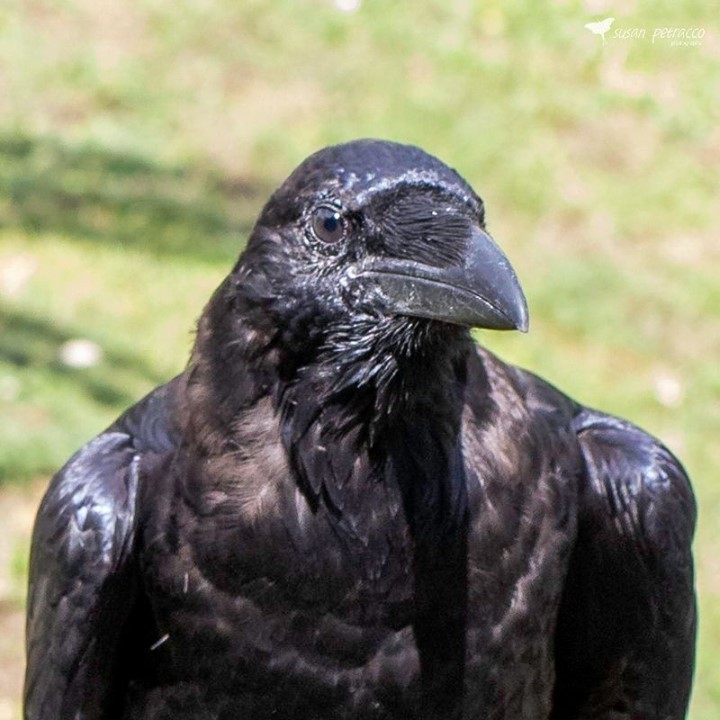
While you visit, keep an eye out for these comical and sometimes aggressive animals. They are a beloved feature and England goes to great lengths to take care of them. There is one Yeoman Warder whose sole job is to care for the ravens. With the addition of “Ravenmaster” at the end of his title, Christopher Skaife holds this honor. If you’re interested in learning more about his life caring for these intelligent birds, I highly recommend his book Ravenmaster (available on Amazon).
Here’s a funny quick story. While visiting the Tower, I accidentally dropped a one-pound coin on the ground. It was quickly snatched up by the closest raven! I was scared to death it would choke on the coin and die, and England would fall, and it would be entirely my fault! So I tried to get the coin back. I didn’t succeed, but I did get bit. Later, after I was home and while I was reading The Ravenmaster, I was able to figure out that it was Raven George who nipped my finger. George also got to keep my coin!
As it turns out, Raven George’s namesake in the 1980s also had some other bad habits, and was dishonorably discharged from Her Majesty’s service. Serves him right.
Traitor’s Gate
The entrance known as Traitor’s Gate provides water-based access to the Tower of London. It wasn’t originally designed for traitors, though. Traitor’s Gate was added to the Tower by King Edward I (“Longshanks”) to provide personal access to the Tower of London from the Thames River.
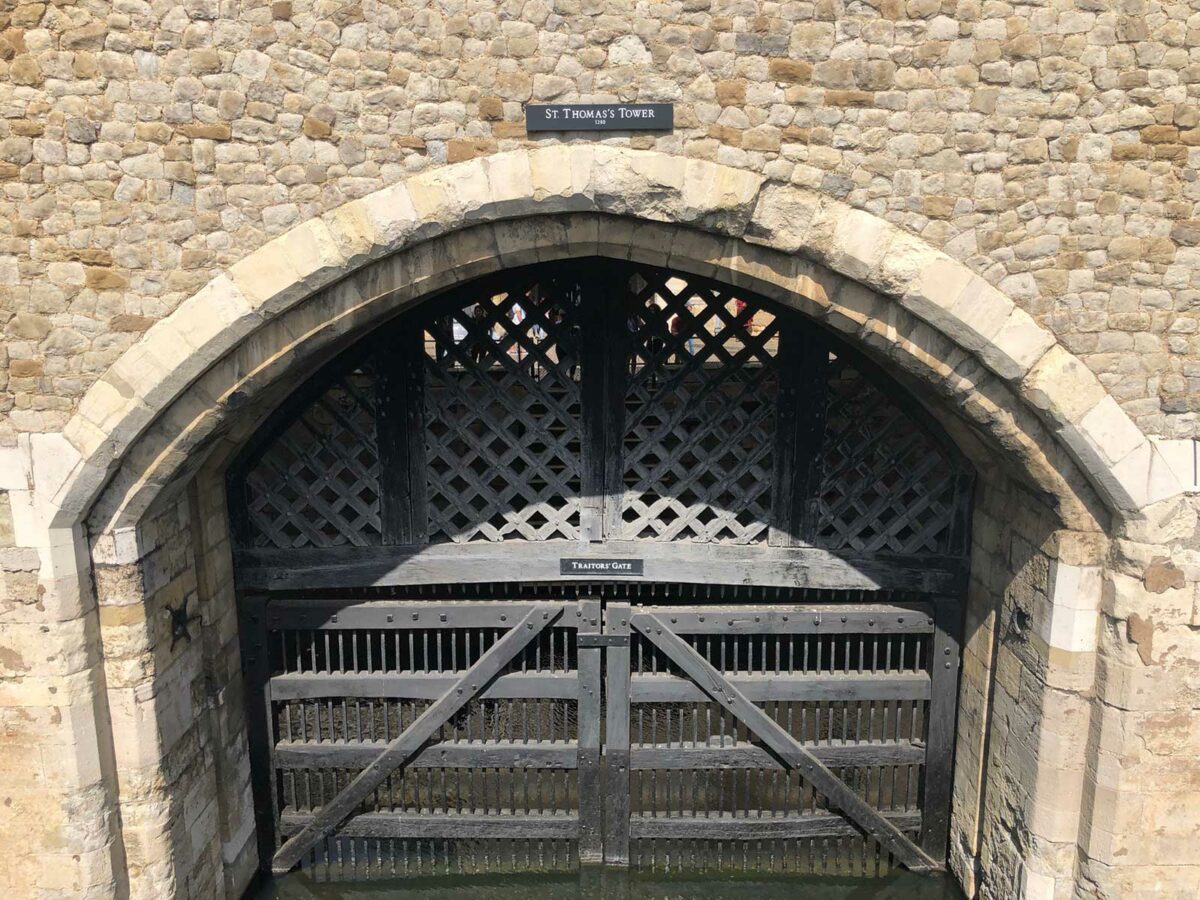
It wasn’t until much later that the Tower of London gained its reputation for housing prisoners and for being the site of their execution. During that time, the entrance became known as Traitor’s Gate. Many prisoners were unfortunate enough to enter the Tower through Traitor’s Gate, including Sir Thomas More, Queen Anne Boleyn, Queen Catherine Howard, Lady Jane Grey (The Nine Day’s Queen), and Princess Elizabeth (later to be crowned Queen Elizabeth I). Many never left the Tower again.
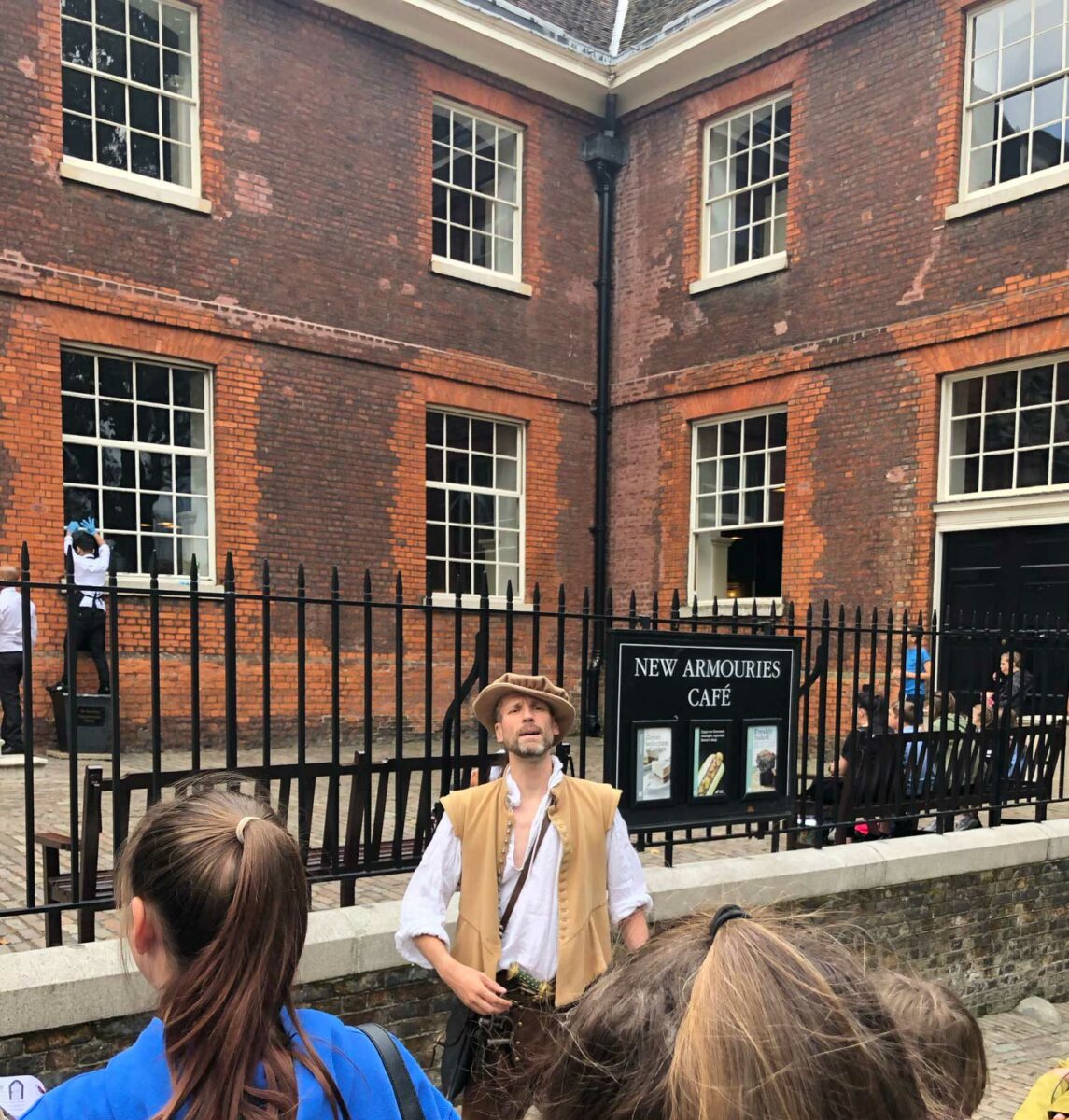
Historical Reenactments
One of the most entertaining things to do at the Tower of London, is to participate in one of their historical reenactments. Actors put on fun-yet-informative reenactments of famous events that have taken place over the centuries. It’s a fabulous way to bring the history of the Tower to life! The actors take great care not to break character, which helps you to imagine that you’re really a part of the history.
The reenactment we watched included John Gerard’s escape – and the actor pretended to fall so believably that we all gasped. The entire performance was incredibly entertaining!
The reenactment are really educational, so they are great for children, as well as adults who are interested in the fascinating history of the Tower of London.
The White Tower and the Princes in the Tower
There’s a lot to see inside the White Tower, which sits right in the middle of the Tower of London complex. As I mentioned earlier, this is the oldest and original building on the grounds. You climb a set of stairs outside of the tower before entering, and along the way, you’ll see the sign for the Princes in the Tower.
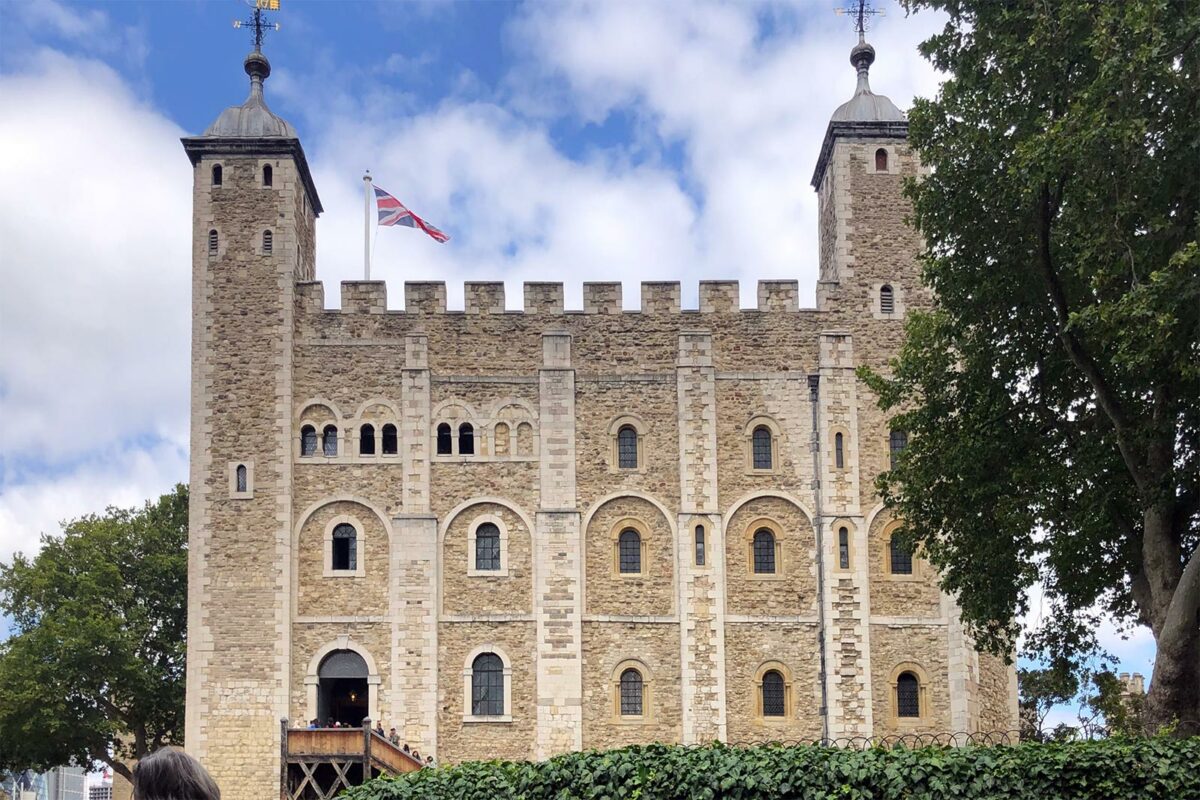
This tragic story tells of the two young children of King Edward IV, after he was deposed in battle as part of the Wars of the Roses. When he died in 1483, the boys were placed in the protection of his brother, Richard, Duke of Gloucester. The young princes were kept at the Tower awaiting coronation of the older one, when they were declared illegitimate and Richard ascended the throne as Richard III. The boys, aged 12 and 9, were never seen again.
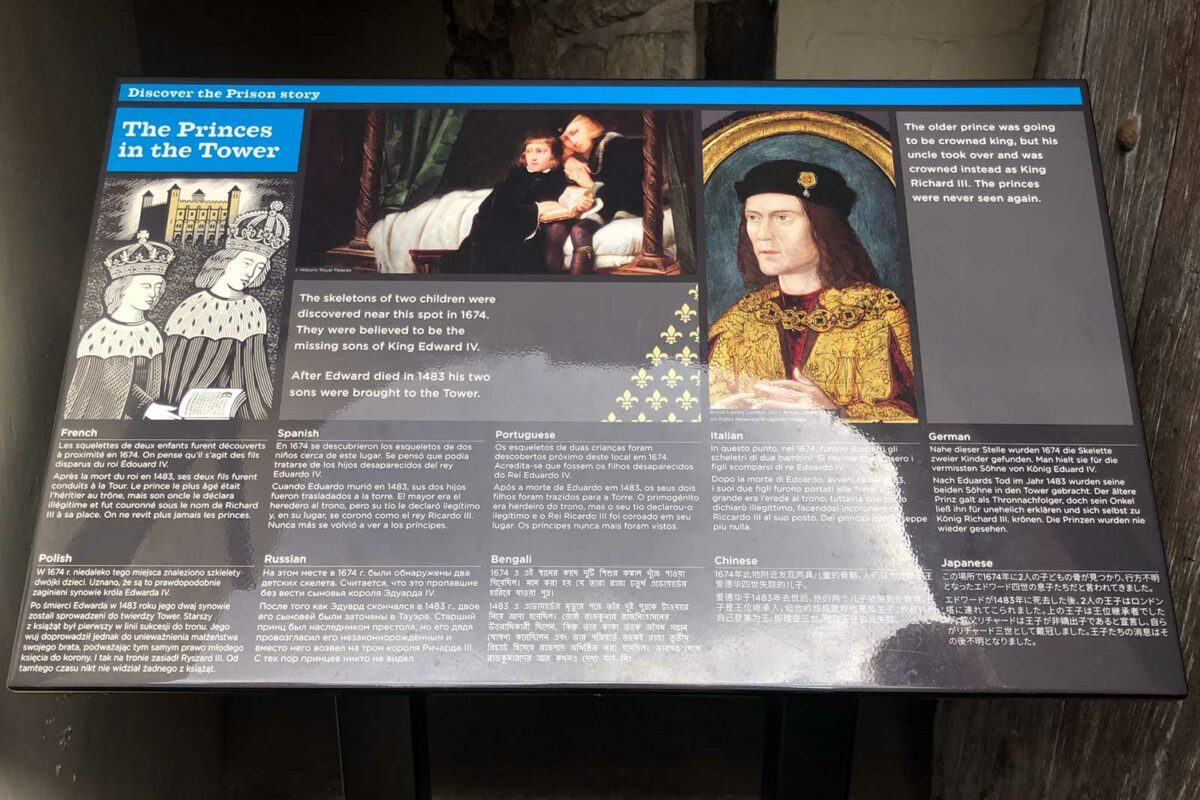
In 1674, the bones of two young boys were found under a set of stairs (not the same ones you climb outside) and exhumed by a workman. It is presumed that they are the remains of the princes, but it has never been proven and no attempts at proof have been made. The role that their uncle played in their death is a hotly debated topic among historians, both professional and amateur.

Once inside the White Tower, you’ll find the Line of Kings display, which has many representations of armor from the history of England, including two suits of armor worn by King Henry VIII. The Line of Kings, as a museum display, itself dates back to the 17th century! And the pieces inside are much older, in many cases.
You’ll also find the beautiful Chapel of St. John, which is where the bodies of the young princes were found. Its beautiful stained-glass windows were added by King Henry III in 1240.
Fans of medieval torture devices will enjoy (shudder) the excellent display on the top floor.
The Wire Sculptures of Animals
The Tower of London has, as part of its storied history, been used as a menagerie, or a kind of zoo. Having exotic animals helped to display the wealth and might of English monarchs. Some of the Tower’s animal residents were lions and tigers, elephants and zebras, and even a polar bear who was kept on a chain and allowed to fish in the Thames! (A sad but interesting tale.)
In 2010, an artist named Kendra Haste was commissioned to create 13 wire sculptures of the animals once kept at the Tower of London Menagerie. Today when you visit, you’ll see the sculptures in various locations throughout the Tower grounds. The sculptures include the infamous polar bear, three monkeys, several lions, and elephant, and more.
When the Tower of London’s menagerie was closed, the remaining 150 animals were moved to Regent’s Park as part of the London Zoo. These beautiful sculptures stand in their memory.
Church of St Peter ad Vincula
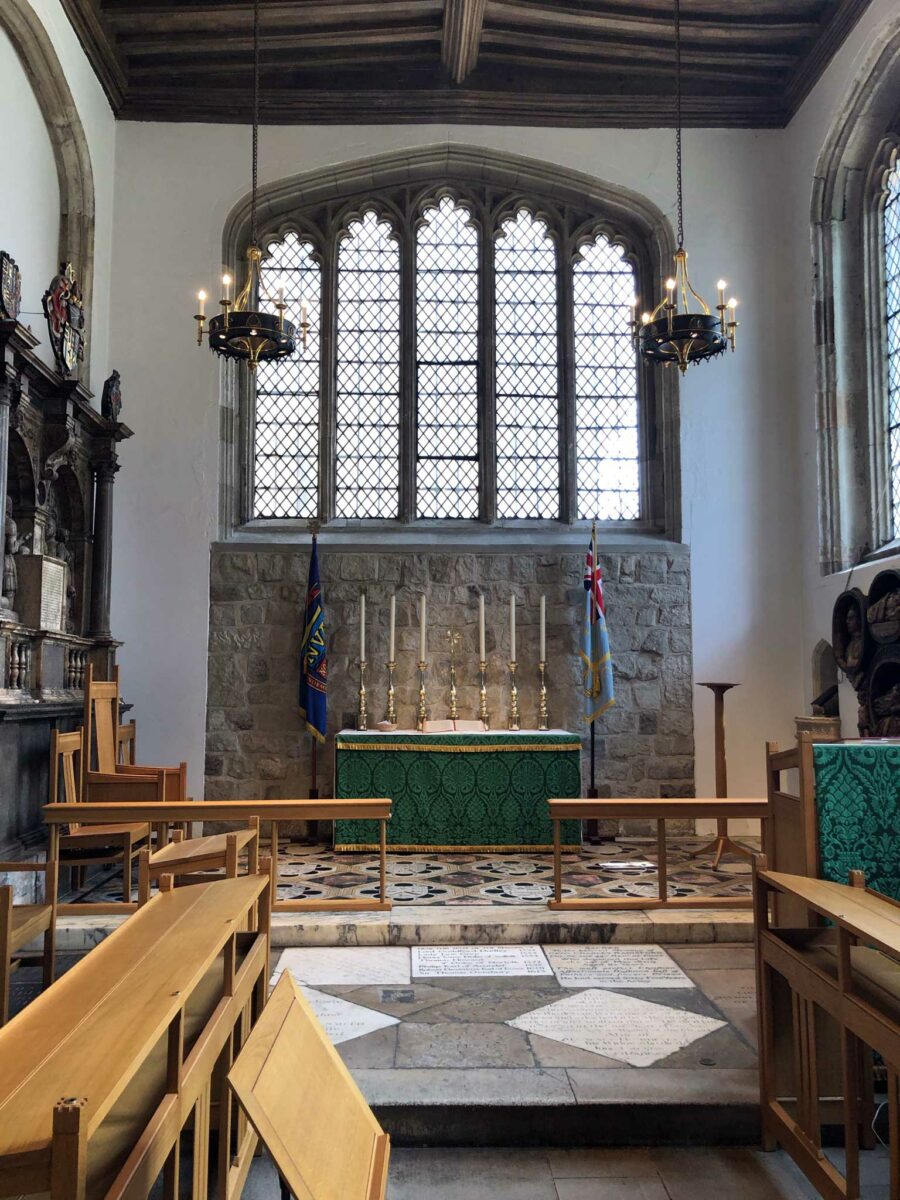
The Church of St Peter ad Vincula, sometimes called the Chapel of St Peter ad Vincula, is the former parish church for the Tower of London. It sits within the inner ward portion of the Tower grounds. The church building was completed in 1520, and features strong Tudor influences in its design.
The chapel is best known as the burial place of many famous historical people, some of whom were executed at the Tower. The Church of St Peter ad Vincula is the final resting place of Queens Anne Boleyn and Catherine Howard, two of the wives of King Henry VIII; Lady Jane Grey, the Nine Days’ Queen, and her husband are also interred there. Some additional people buried in the church include George Boleyn, Anne’s brother; two tax collectors for King Henry VII; Thomas Cromwell, King Henry VIII’s minister; and Thomas Seymour, the brother of Jane Seymour. A list of “remarkable persons” buried in the church is displayed within the chapel.
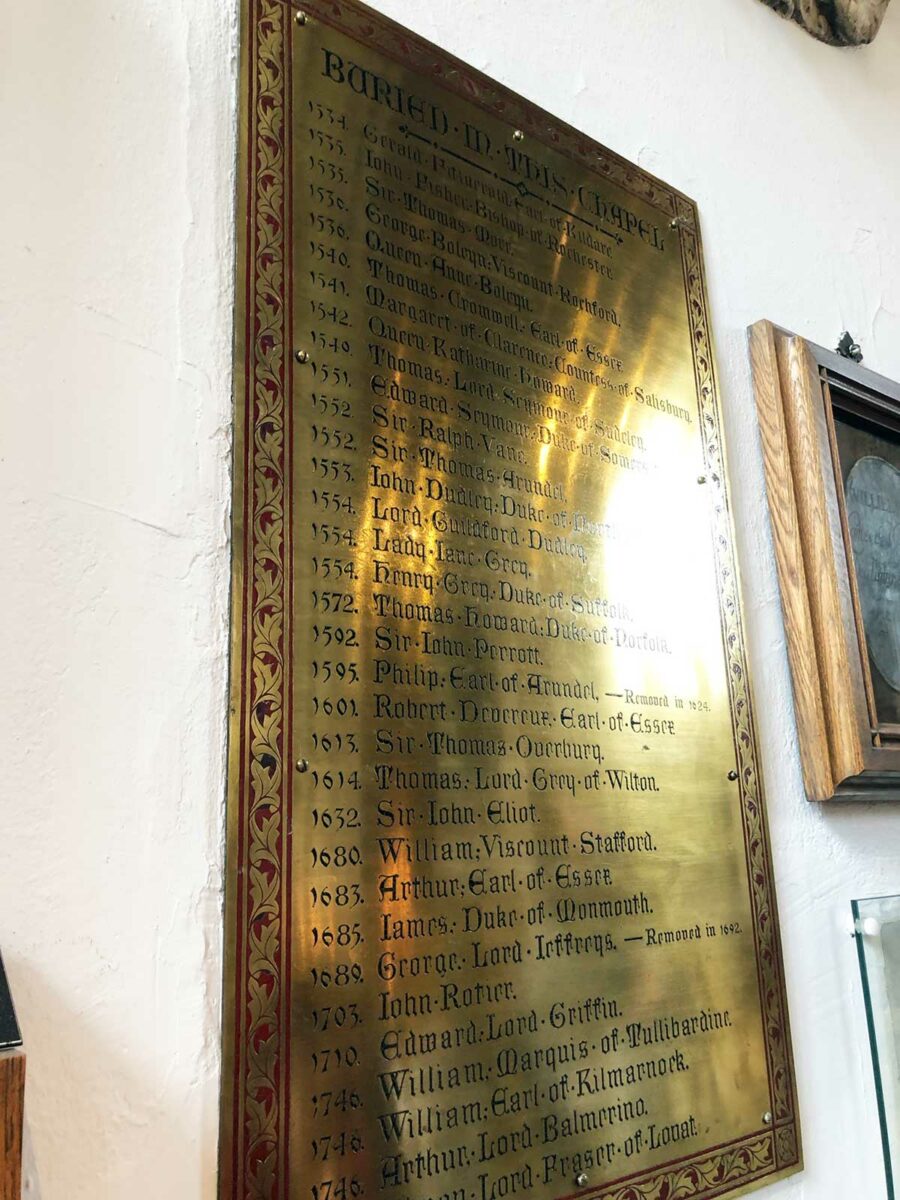
The Church of St Peter ad Vincula and its burials is one of the most common sources of the various ghosts that inhabit the property. The most famous ghost in the tower of London is, of course, Anne Boleyn’s. Her ghost has been seen around the grounds carrying her severed head. She was executed by beheading with a sword at the Tower, so if she’s going to haunt any place, the Tower of London is probably her best option!
Near the church, you’ll notice a number of bright blue doors. These are entrances to the homes of the Yeoman Warders, the ceremonial guards, and their families. Supposedly they are blue because they are painted with leftover paint from the Tower Bridge.
The church is an active place of worship and conducts services on Sundays.
Tower Hill Tube Station
The easiest way to get to the Tower of London – or anywhere else in London – is to take the Tube. (“The Tube” is the nickname for the London Underground, the subway system of the city.) There is a tube station just across the street at Tower Hill. The District and Circle lines stop at this station, and once you exit, it’s a short walk to the Tower. As an added bonus, on the way, you’ll pass one of the largest still-standing sections of the old Roman wall that was built in the 200s, and which used to surround the city of London.
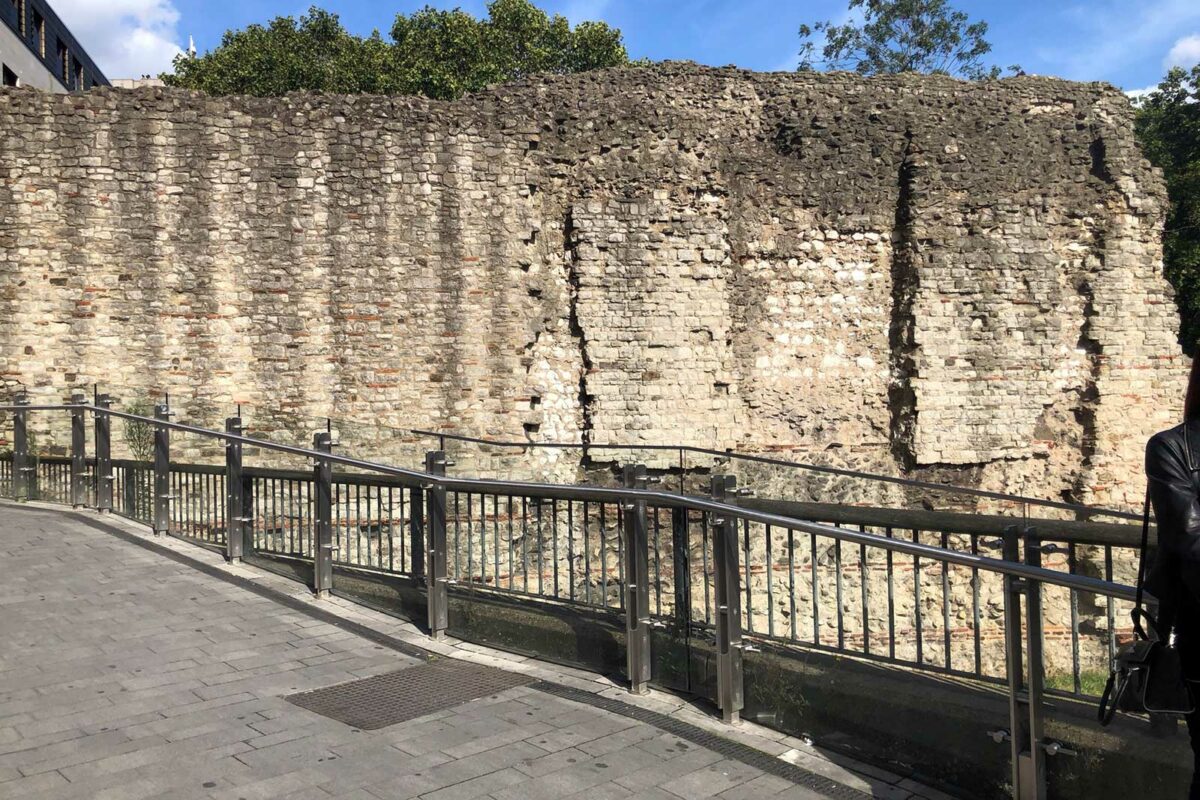
Just across from Traitor’s Gate is a pedestrian path and then the Thames. This is the view of the Tower Bridge from outside the tower.
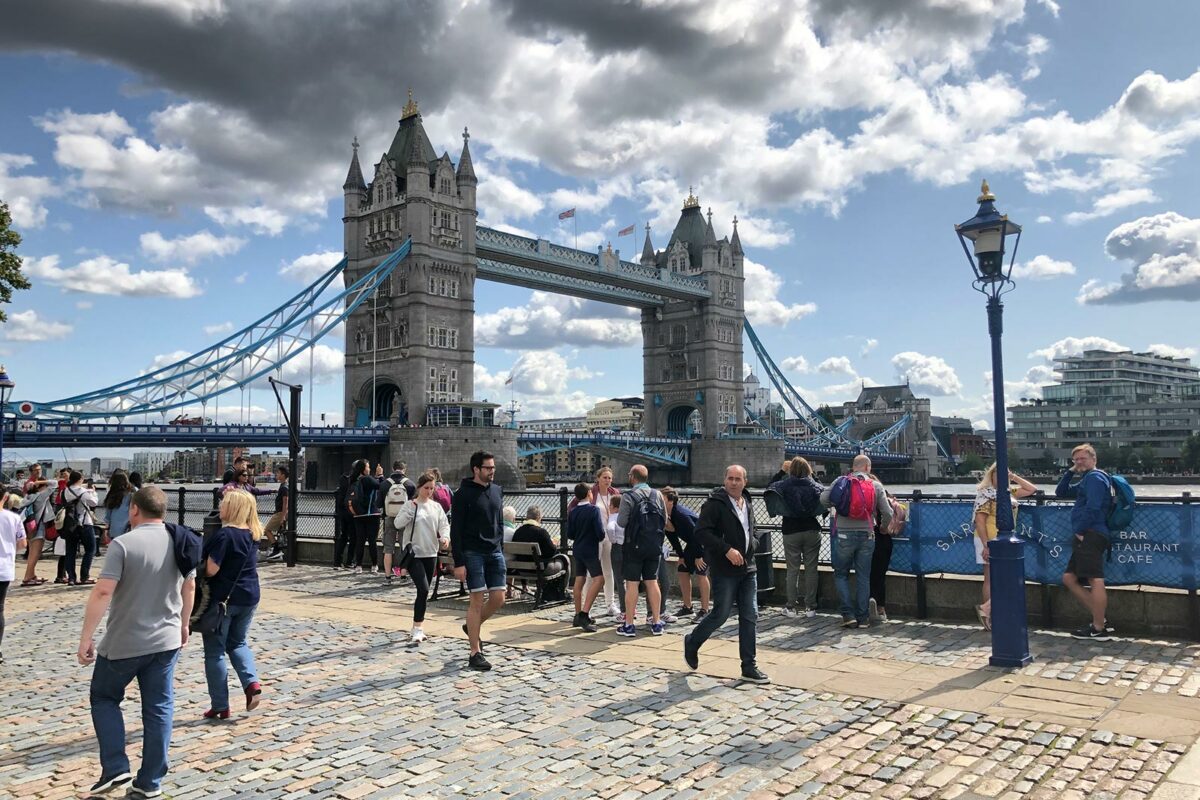
I’m very excited because we have upcoming tickets to the Keys Ceremony, an ancient tradition where they lock up the Tower each night. I’ll be sure to report back and, most likely, link to a new post! We’ll also get to see the display of metal poppies that commemorates World War I.

